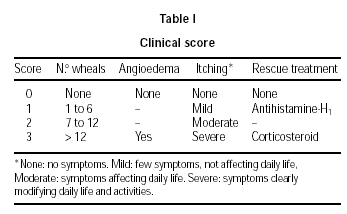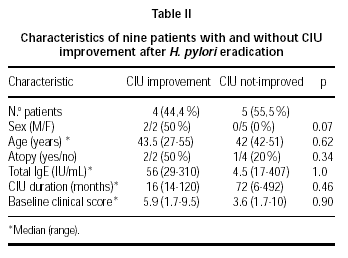INTRODUCTION
Helicobacter pylori is the most common chronic bacterial human infection worldwide. It causes some of the most prevalent gastroduodenal diseases such as peptic ulcer disease, gastric cancer and B-cell gastric lymphoma. It has also been associated with other extradigestive conditions such as cardiovascular, immunological or skin diseases (1).
Chronic urticaria is a long-lasting skin disease characterized by pruritic wheals daily or almost daily for more than six weeks. Chronic urticaria is defined as idiopathic (CIU) when all known conditions causing the disease have been ruled out.
In recent years, some studies have suggested that H. pylori could be involved in the pathogenesis of CIU. Hence, several studies have shown a higher prevalence of H. pylori infection in patients with CIU than in the general population, and occasional remissions of skin lesions have been reported after eradication treatment (2-5). However, other investigations have failed to find a significant improvement after successful eradication (6-8). These differences may be due to pitfalls of design, especially the lack of a control group, in the majority of the studies. The aim of the present study was to investigate the efficacy of H. pylori eradication on CIU in patients affected by both conditions, using a prospective, randomized, double-blind placebo-controlled design.
PATIENTS AND METHODS
Patients
Patients with chronic urticaria of more than three months' duration were recruited from the outpatient allergy clinic of a general hospital in the setting of a small Mediterranean town. All were entered in a study protocol in which data of the following were colleted: physical examination, common tests for physical urticarias, complete blood count, ESR, liver and renal function tests, chest X-rays, abdominal ultrasound study, skin tests to common inhalant and food allergens, stool analysis for parasite ova, serum tests for hepatitis B and C viruses and Treponema, thyroid function tests, ANA, anti-thyroglobulin and anti-peroxidase antibodies, C3, C4, IgG, IgM, IgA and IgE. Patients with negative results were tested for H pylori infection with a 13C urea breath test (Microvir-Helicobacter pylori, Instituto Valenciano de Microbiología, Bétera, Spain). Patients with positive results were then scheduled for endoscopy with corpus and antral mucosa biopsies. The presence of H. pylori infection was established by a positive biopsy urease-test (Ballard Medical Products, Draper, Utah) or identification of H. pylori by histology study.
Methods
The patients in whom H. pylori infection was confirmed at least by biopsy urease test or histologic identification and who remained symptomatic were randomly assigned to a 7-day double-blind, placebo-controlled treatment. The treatment consisted of amoxicillin 1 g b.i.d; clarithromycin 500 mg b.i.d and omeprazole 20 mg, b.i.d or the corresponding placebos. H. pylori eradication was confirmed by a second 13C urea breath test six weeks after the end of treatment. The study was approved by the Ethics Committee of the Hospital and all patients gave their informed consent.
The effect of eradication on CIU was evaluated by a daily clinical score, including several urticaria symptoms and use of rescue treatment (table 1), measured the week before eradication therapy (baseline) and the sixth week after treatment. Only the disappearance of the urticaria or a decrease of at least 70 % in the baseline score were considered as significant.
Descriptive analysis was performed using absolute and relative frequencies for categorical variables and medians and ranges for quantitative variables. Intergroup comparisons were made using the x2 test for categorical variables and the Mann-Whitney U test for quantitative variables. The level of statistical significance was set at p # 0.05. All analyses were performed with the statistical software package SPSS 6.1.
RESULTS
From a total of 106 patients screened, 88 were diagnosed of CIU. The 13C urea breath test was positive in 49 of these (56 %). Twenty-seven patients were excluded: eight because of spontaneous disappearance of wheals, four refused to undergo endoscopy and the remaining fifteen for personal reasons, including reluctance to participate in placebo trials. In two additional patients, both Clo-test and histology failed to confirm H. pylori infection. Therefore, only 20 patients were included in the study. Sensitivity of the 13C urea breath test compared to endoscopic tests was 91 %. No patient presented gastrointestinal symptoms or endoscopic lesions.
Nine of the ten patients assigned to active treatment and three of the ten assigned to placebo eradicated H. pylori infection. One patient from the placebo group dropped out of the study for accidental reasons. For the final analysis and, given that the probability of spontaneous H. pylori eradication in adults is very small (9), we excluded the 3 patients who showed a negative second 13C urea breath test after being treated with placebo.
CIU improved significantly in 4 of the 9 patients (44.4 %) who eradicated H. pylori infection after active treatment and in 1 of the 7 (12.3 %) who did not (p = 0.19). No clinical differences in CIU characteristics were found between patients with and without improvement (table 2). No serious adverse effects were observed in either treatment group.
DISCUSSION
The reported prevalence of H. pylori infection in CIU patients is high, ranging from 24 to 80 % depending on the geographical area and patients' age (2, 7, 8). We found a prevalence of 56 %, in agreement with other Spanish authors (4, 6) which is similar to that of the general population.
In the present study, a tendency towards improvement with successful eradication was seen, although these results did not reach statistical significance. As chronic urticaria usually shows an erratic nature and, moreover, may disappear spontaneously in the first 6 months in approximately half the patients (7, 10), very strict conditions in the trial design were established, yielding a small number of recruited patients.
Our results are in the range of previous studies, in which CIU improvement varies from 13 % to almost 100 % (2-4, 11). In the only other double-blind placebo-controlled study by Schnyder et al (7), only three patients eradicated H. pylori and, therefore, result was inconclusive.
In summary, since in some patients remission of a long-lasting urticaria after H. pylori eradication was observed without adverse effects, we believe that a trial of H. pylori eradication should be offered to patients with CIU and evidence of H. pylori infection. The high sensitivity of the 13C urea breath test makes it the most convenient and cost-effective screening test for H. pylori infection in these patients. The results of this study support further investigation into the involvement of H pylori infection in CIU and offer the possibility of an effective treatment for a chronic, symptomatic, quality-of-life-affecting disease.
ACKNOWLEDGEMENTS
We gratefully acknowledge Dr Montserrat Olona for performing the statistical analysis of the data and Abbott Laboratories SA (Madrid, Spain) for partial financial support and logistic help.








